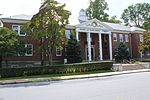Peekskill meteorite

The Peekskill meteorite is among the most historic meteorite events on record. Sixteen separate video recordings document the meteorite burning through the Earth's atmosphere in October 1992, whereupon it struck a parked car in Peekskill, New York, United States. The Peekskill meteorite is an H6 monomict breccia; its filigreed texture is the result of the shocking and heating following the impact of two asteroids in outer space. The meteorite is of the stony variety and approximately 20% of its mass is tiny flakes of nickel-iron. When it struck Earth, the meteorite weighed 27.7 pounds (12.6 kg) and measured one foot (0.30 m) in diameter. The Peekskill meteorite is estimated to be 4.4 billion years old.
Excerpt from the Wikipedia article Peekskill meteorite (License: CC BY-SA 3.0, Authors, Images).Peekskill meteorite
Wells Street,
Geographical coordinates (GPS) Address Nearby Places Show on map
Geographical coordinates (GPS)
| Latitude | Longitude |
|---|---|
| N 41.286388888889 ° | E -73.916388888889 ° |
Address
Wells Street 207
10566
New York, United States
Open on Google Maps







